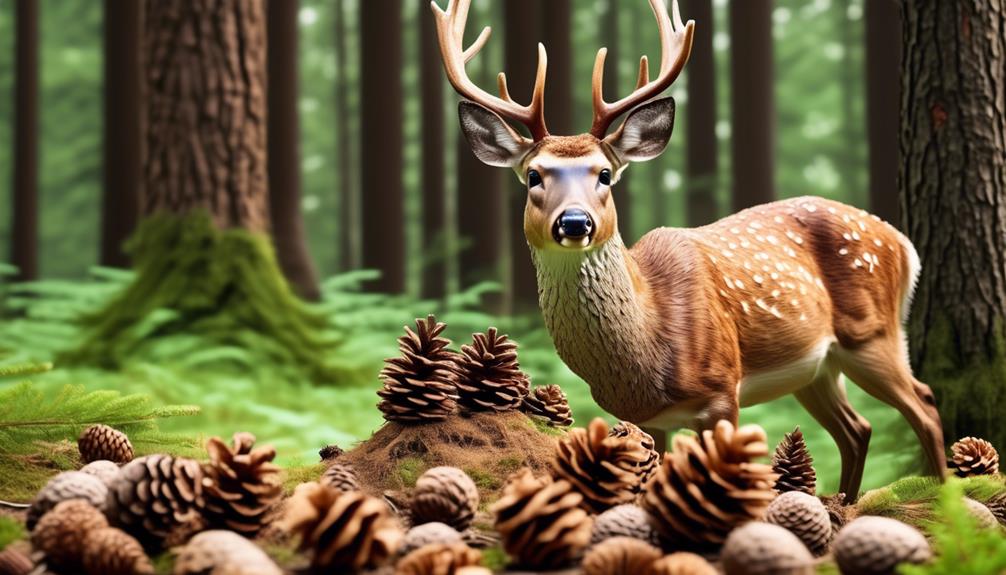Have you ever wondered why deer have a peculiar fondness for munching on pine cones? It’s quite fascinating to learn that deer are drawn to pine cones because of the sweet seeds they contain. These seeds not only offer a delectable flavor but also provide essential calories and nutrients that support their growth, especially in younger deer.
But that’s not all! Pine cones serve as a reliable source of sustenance when food becomes scarce. In this article, we will explore the reasons behind deer’s affinity for pine cones and discuss practical tips to protect your trees from deer damage.
So, if you’re curious about this peculiar behavior and want to ensure your trees remain intact, let’s uncover some fascinating insights together.
Reasons Why Deer Eat Pine Cones
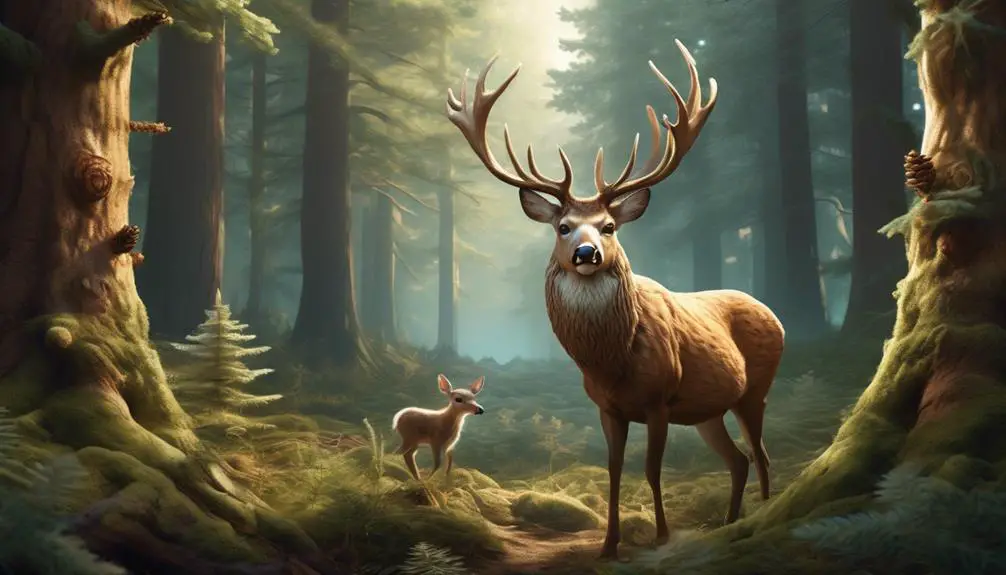
Deer eat pine cones primarily because of the sweet taste and the nutritional benefits they provide. Pine cones contain pine nuts, which are rich in calories and nutrients. For deer, especially younger ones, consuming pine cones supports their growth and development. Additionally, pine cones serve as a source of food when other options are scarce. Unlike humans, deer can’t go out and buy food, so they rely on natural choices like pine cones. The availability of pine cones may even be an evolutionary advantage for deer, as they’ve adapted to utilize this resource when necessary.
Pine cones offer a natural and nutritious food source for deer. They’re packed with energy-rich pine nuts that provide essential nutrients for their overall well-being. These seeds are a valuable food source, especially during periods of low food availability. The sweet taste of the pine nuts also appeals to deer, making pine cones a favored food choice. This preference for pine cones has been observed in white-tailed deer, as they’re more likely to consume pine cones compared to other species.
Nutritional Benefits of Pine Cones for Deer

Pine cones provide essential nutrients and calories that contribute to the overall health and development of deer. These cone-shaped structures contain a valuable food source for deer, particularly during times when other forage options may be scarce. Pine cones are rich in pine nuts, which are packed with energy and essential nutrients. The nuts within the cones are high in fat and protein, providing deer with the necessary fuel for growth, reproduction, and maintaining their overall well-being.
The high caloric content of pine cones makes them an attractive food source for deer, especially during the cold winter months when energy requirements are significantly higher. Additionally, the presence of important nutrients such as vitamins, minerals, and antioxidants in pine cones further enhances their nutritional value for deer. These nutrients play a vital role in supporting various biological processes, including bone development, muscle growth, and immune function.
It is important to note that while pine cones offer nutritional benefits, they shouldn’t be the sole source of food for deer. A diverse diet that includes a variety of forage, browse, and other natural food sources is essential for optimal deer health. However, the inclusion of pine cones in their diet can provide deer with a supplemental and valuable source of nutrients and calories, ultimately contributing to their overall vitality and survival.
Pine Cones as a Food Source During Scarcity
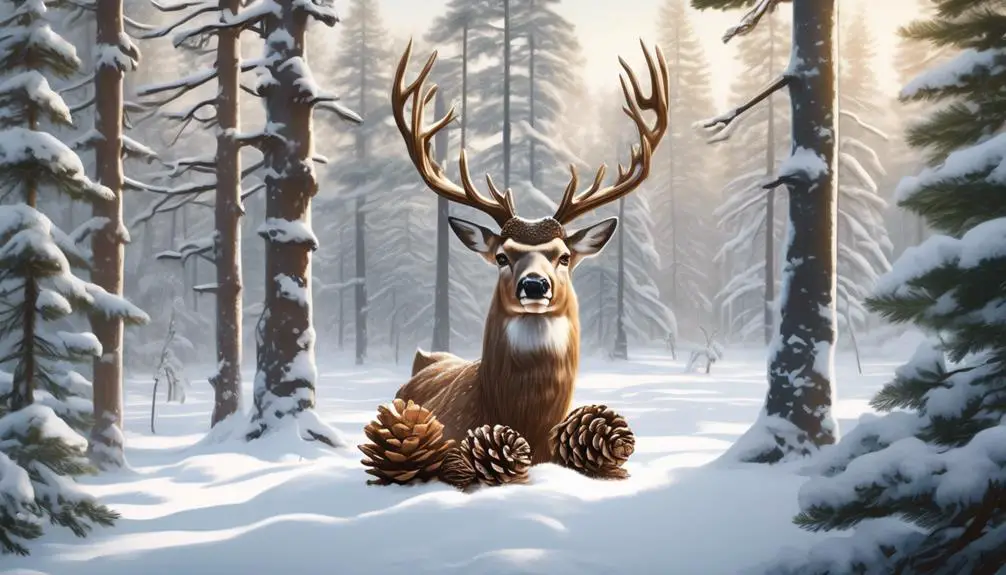
During times of limited food resources, you’ll find that deer rely on the nutritional benefits provided by pine cones. When other food options become scarce, deer turn to pine cones as a valuable source of sustenance.
Pine cones contain seeds, often referred to as pine nuts, which are rich in calories and nutrients. These seeds provide much-needed energy for deer, particularly during periods of scarcity. While deer can’t go out and purchase food like humans, they’ve evolved to take advantage of the natural availability of pine cones.
It’s believed that the taste and nutritional value of pine cones make them an attractive food source for deer. This preference has been observed in studies, with white-tailed deer showing a greater inclination to consume pine cones compared to other species.
Therefore, during times when food resources are limited, deer rely on the nutritional benefits provided by pine cones to sustain their growth and survival.
Pine Cones as a Natural Choice for Deer
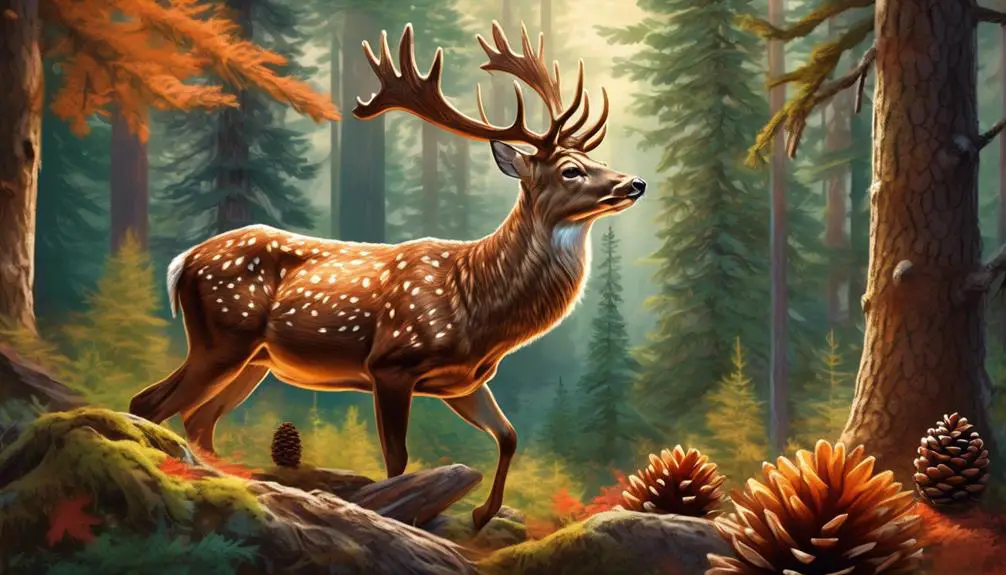
When faced with limited food resources, deer instinctively turn to pine cones as a natural and nourishing option for sustenance. Pine cones serve as an important food source for deer, providing them with essential calories and nutrients. The sweet seeds found within pine cones are particularly enticing to deer, satisfying their taste preferences. This natural choice of consuming pine cones supports growth, especially in younger deer who require adequate nutrition for their development.
The availability of pine cones in the environment may have evolutionary advantages for deer. When other food options are scarce, such as during winter months or in areas with depleted vegetation, deer rely on the abundance of pine cones to meet their dietary needs. Unlike humans who have the luxury of purchasing food, deer have evolved to utilize natural resources like pine cones as a means of survival.
Studies have shown that white-tailed deer are more likely to consume pine cones compared to other species. This preference may be due to the nutritional benefits they offer. Pine cones contain pine nuts, which are rich in fats and proteins, providing a valuable energy source for deer.
Evolutionary Advantage of Pine Cones for Deer
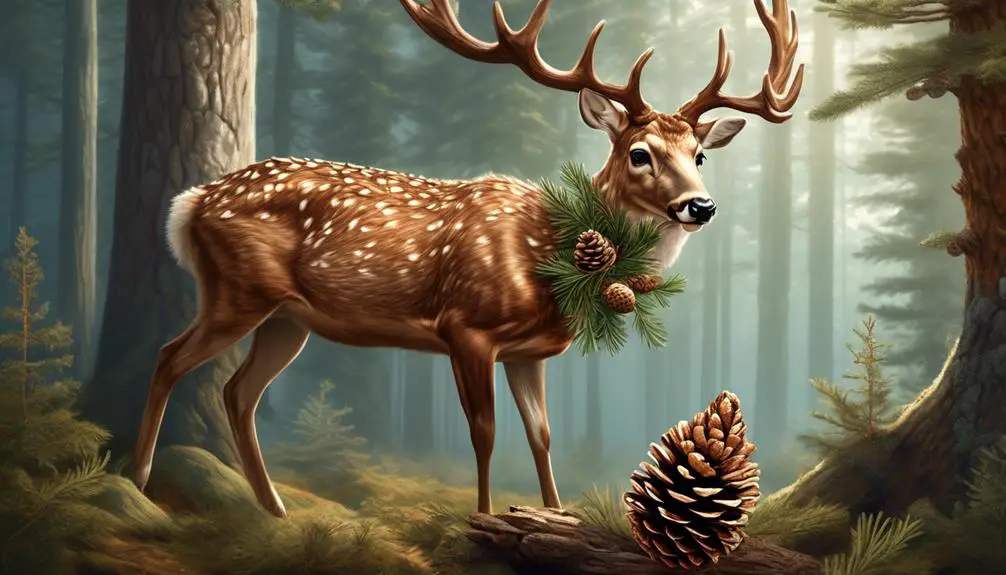
Pine cones provide an evolutionary advantage for deer due to their nutritional benefits and natural availability.
The sweet seeds found within pine cones offer a source of calories and nutrients that support growth, particularly in younger deer.
Additionally, pine cones serve as a valuable food source when other options are scarce, making them a beneficial adaptation for deer survival.
Pine Cone Nutritional Benefits
Deer have evolved to benefit from the nutritional advantages provided by consuming pine cones.
Pine cones offer a variety of nutritional benefits that contribute to the growth and survival of deer populations.
Firstly, pine cones contain a substantial amount of calories, which are essential for energy production and maintenance of bodily functions.
Additionally, pine cones are rich in nutrients such as proteins, fats, and carbohydrates, which are necessary for the deer’s growth and development. These nutrients support muscle growth, bone formation, and overall health.
Moreover, pine cones provide essential vitamins and minerals, including vitamin E, vitamin K, magnesium, and manganese. These micronutrients contribute to various physiological processes and enhance the deer’s immune system.
Pine Cones as Natural Food Source
As we continue our exploration of the nutritional benefits of pine cones, it’s important to delve into the evolutionary advantage these natural food sources provide for deer.
Pine cones serve as a critical food source for deer, particularly during times of scarcity. The ability of deer to consume pine cones offers them a competitive edge in their ecosystem.
The seeds found within pine cones are rich in calories and nutrients, supporting the growth and development of deer, especially younger individuals. By consuming pine cones, deer can obtain vital energy and sustenance, allowing them to survive when other food options are limited.
This evolutionary adaptation enables deer to sustain themselves and thrive in challenging environments. The availability and consumption of pine cones have thus become advantageous traits that have been selected for over generations, ensuring the survival and success of deer populations.
Encouraging Deer to Eat Pine Cones
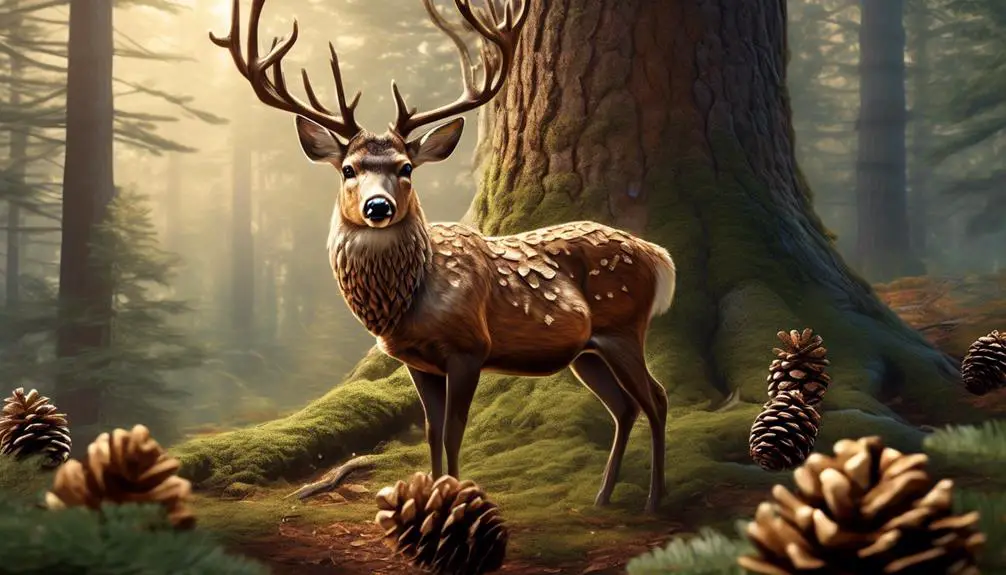
Encouraging the consumption of pine cones by deer can be facilitated through various methods that enhance their appeal as a nutritional food source.
One method to encourage deer to eat pine cones is by providing them as a toy. Previous studies have shown that white-tailed deer are more likely to eat pine cones compared to other species. By providing a natural environment where deer can choose to eat pine cones, their preference can be determined.
Additionally, understanding deer preferences and behaviors can inform tree selection for your property. Deer are less likely to eat plants with thick or jaggy needles or bitter or gummy textures, so planting trees that are less attractive to deer can help prevent damage.
Using Pine Cones as a Toy for Deer

Using pine cones as a toy for deer can enrich their environment, stimulate natural behaviors, and promote physical activity.
Deer are naturally curious creatures and providing them with pine cones to interact with can help keep them mentally and physically engaged.
By encouraging deer to play with pine cones, they can engage in behaviors such as tossing, rolling, and manipulating objects, which mimic their natural foraging and exploration activities in the wild.
This can contribute to their overall well-being and enhance their natural instincts.
Enriching Deer Environment
Deer find pine cones to be an engaging and enriching addition to their environment. Pine cones can serve as a natural toy for deer, providing them with mental stimulation and physical activity. When deer encounter pine cones, they may engage in behaviors such as batting them with their hooves or tossing them in the air. These interactions not only help to alleviate boredom but also promote the development of coordination and agility in deer.
Additionally, pine cones can serve as a source of sensory enrichment for deer. The rough texture of the pine cone scales can provide tactile stimulation, while the scent of the pine resin can contribute to olfactory enrichment.
Stimulating Natural Behaviors
To stimulate natural behaviors in deer, incorporating pine cones as a toy into their environment can provide opportunities for mental and physical engagement. Pine cones offer a unique and interactive object for deer to interact with, encouraging behaviors that are intrinsic to their natural instincts.
When presented with pine cones, deer may engage in activities such as pawing, tossing, and pushing the cones with their hooves, as well as manipulating them with their mouths. These actions help to simulate foraging behaviors, as deer in the wild often encounter pine cones while searching for food.
Additionally, the texture and shape of pine cones can provide sensory stimulation for deer, promoting curiosity and exploration. By incorporating pine cones as a toy, deer are given the chance to engage in natural behaviors, promoting overall well-being and mental stimulation in their captive environment.
Promoting Physical Activity
Can incorporating pine cones as a toy promote physical activity in deer?
While there’s limited scientific research specifically addressing this question, anecdotal evidence suggests that deer may engage in physical activity when interacting with pine cones. Deer are naturally curious animals, and providing them with pine cones as a form of environmental enrichment can stimulate their natural behaviors, such as exploration and play.
When given access to pine cones, deer have been observed tossing them, batting them with their hooves, and even rolling them around. These actions require physical exertion, which can help promote exercise and overall physical fitness in deer.
Additionally, the act of manipulating pine cones may provide mental stimulation for the deer, leading to increased activity levels.
Further research is needed to fully understand the extent to which pine cones can promote physical activity in deer.
Pine Cone Preference of White-Tailed Deer
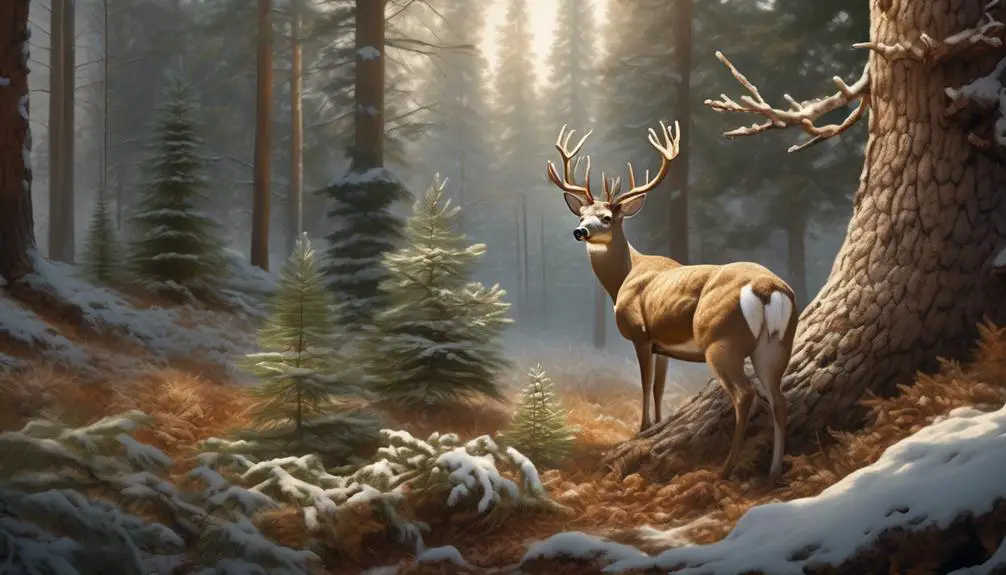
The pine cone preference of white-tailed deer can be influenced by various factors, including the availability of other food sources and the nutritional value of the pine cones themselves. White-tailed deer are known to consume a variety of plant material, including grasses, forbs, and browse. However, when other food sources are limited, they may turn to pine cones as a source of sustenance.
Pine cones provide deer with a source of carbohydrates, fats, and proteins. The seeds within the pine cones, known as pine nuts, are particularly nutritious and provide the deer with the energy they need for growth and survival. Additionally, pine cones are a readily available food source, especially in areas with dense pine forests.
However, not all pine cones are equally appealing to white-tailed deer. Factors such as the age and condition of the cone, as well as the species of pine tree, can influence their preference. Deer may prefer pine cones that are fully mature and have larger seeds, as these are more nutritionally beneficial.
It is important to note that while white-tailed deer may eat pine cones, they don’t solely rely on them for sustenance. Their diet is diverse and varies depending on the season and availability of other food sources. Therefore, the preference for pine cones may change based on the deer’s nutritional needs and the availability of alternative food sources.
Creating a Natural Environment for Deer to Choose Pine Cones
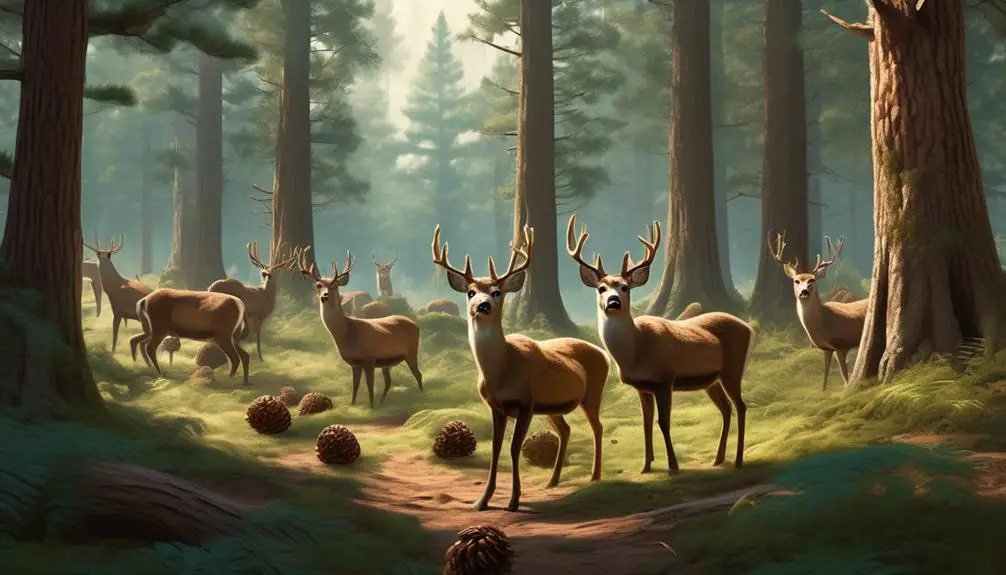
When considering the pine cone preference of white-tailed deer, it’s essential to create a natural environment that allows them to choose pine cones as a viable food source. To encourage deer to eat pine cones, it’s important to understand their nutritional value and appeal to deer behavior. Pine cones contain pine nuts, which are nutritious and provide energy for the deer.
Additionally, previous studies have shown that white-tailed deer are more likely to eat pine cones compared to other species. Providing a natural environment where deer can choose to eat pine cones can help determine their preference. This can be achieved by ensuring a sufficient supply of pine cones in the deer’s habitat.
Planting and maintaining pine trees can help create this environment. It’s also important to protect the pine trees from deer damage by installing fences or using repellents.
Strategies to Keep Deer Away From Pine Trees
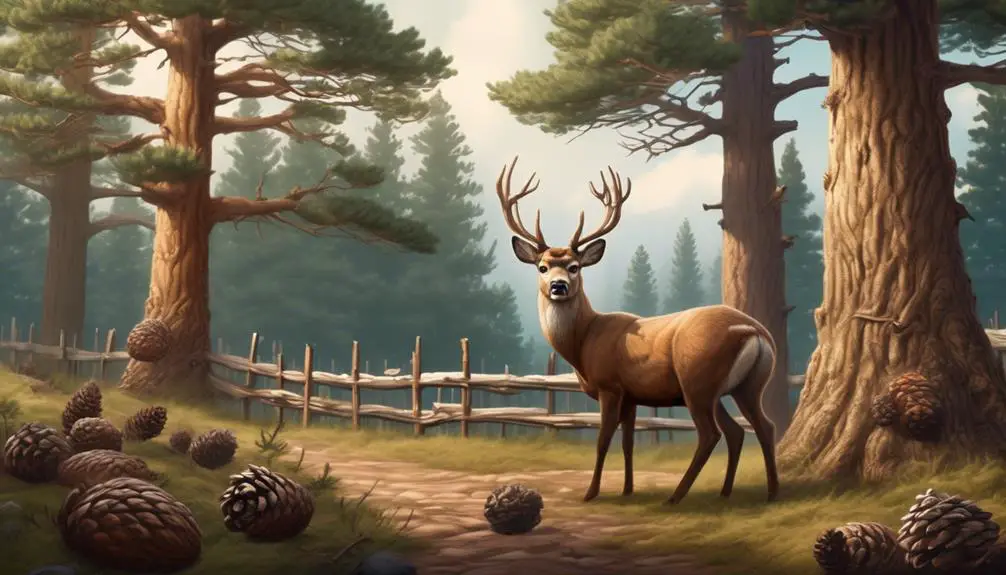
To effectively keep deer away from pine trees, implementing strategic deterrent methods is crucial. There are several strategies you can employ to protect your pine trees from deer damage. One effective method is to install a fence around your property. This physical barrier acts as a deterrent, preventing deer from accessing your trees. Additionally, applying commercial repellents can help deter deer from approaching your pine trees. These repellents often contain ingredients that emit an unpleasant odor or taste to deer, discouraging them from feeding on the trees. Another strategy is to create a deer-resistant tree by planting specific plants that deer find unappealing. Plants with strong aromas, such as lavender or marigolds, can discourage deer from entering your property. Lastly, spraying an unpleasant smell like mint or garlic near your pine trees can also deter deer. By implementing these strategic deterrent methods, you can effectively safeguard your pine trees from deer damage.
| Strategy | Description | Effectiveness |
|---|---|---|
| Install a fence | Physical barrier that prevents deer from accessing pine trees | Highly effective |
| Apply commercial repellents | Repellents emit unpleasant odor or taste to deter deer from feeding on pine trees | Moderately effective |
| Plant deer-resistant plants | Choose plants that deer find unappealing, such as lavender or marigolds | Moderately effective |
| Spray unpleasant smells | Use scents like mint or garlic near pine trees to deter deer | Moderately effective |
Note: Effectiveness may vary depending on the specific circumstances and the persistence of deer in the area.
Using Commercial Repellents to Deter Deer

To deter deer from approaching pine trees, commercial repellents can be an effective solution. These repellents work by emitting unpleasant smells or tastes that deer find unappealing.
There are different types of commercial repellents available, including sprays, granules, and electronic devices. The effectiveness of these repellents may vary, so it’s important to choose the right one for your specific needs and consistently apply it according to the manufacturer’s instructions.
Effectiveness of Repellents
Using commercial repellents can be an effective method to deter deer from approaching pine trees. These repellents are specifically designed to target the sensitive sense of smell that deer possess. Commercial deer repellents often contain strong-smelling ingredients such as putrescent eggs, garlic oil, or capsaicin, which emit odors that are offensive to deer.
When applied to pine trees, these repellents create an unpleasant scent barrier that discourages deer from coming near. The effectiveness of commercial repellents can vary depending on factors such as weather conditions, deer population density, and the specific product used. It’s important to carefully follow the instructions provided by the manufacturer and reapply the repellent as needed.
It’s also worth noting that some deer may become accustomed to the scent over time, so rotating different types of repellents or using them in conjunction with other deterrent methods may enhance effectiveness.
Different Types of Repellents
Different types of commercial repellents can be used to effectively deter deer from approaching pine trees. These repellents are formulated with ingredients that emit odors or tastes that are unpleasant to deer.
One type of commercial repellent is a liquid spray that can be applied directly to the pine trees or surrounding areas. These sprays often contain natural substances such as garlic, mint, or predator urine, which deter deer through their strong odors.
Another type of repellent is a granular product that can be spread around the base of the trees. These granules release an odor that’s offensive to deer and discourages them from approaching.
Additionally, there are motion-activated repellent devices that emit ultrasonic sounds or flashing lights, which startle deer and cause them to flee.
These different types of commercial repellents provide options for effectively deterring deer and protecting pine trees from damage.
Creating a Deer-Resistant Tree Using Specific Plants

Deer-resistant trees can be created by selecting specific plant species that are less appealing to deer for browsing and feeding. By incorporating these plants into your landscape, you can help protect your trees from deer damage. Here is a table showcasing five plant species that are known for their deer-resistant properties:
| Plant Species | Characteristics |
|---|---|
| Arborvitae (Thuja occidentalis) | Dense foliage with a strong scent that repels deer |
| Japanese Spurge (Pachysandra terminalis) | Low-growing ground cover with glossy leaves that deer find unappetizing |
| Boxwood (Buxus) | Evergreen shrub with thick, leathery leaves that deer tend to avoid |
| Fragrant Sumac (Rhus aromatica) | Spreading shrub with aromatic leaves that deer find unpalatable |
| American Holly (Ilex opaca) | Thorny leaves and bright red berries that are less favored by deer |
These plant species possess characteristics that make them less attractive to deer, reducing the likelihood of browsing and feeding. Incorporating a combination of these plants into your landscape can create a deer-resistant environment for your trees. However, it’s important to note that while these plants are generally less appealing to deer, there is no guarantee that they will completely deter deer from your property. It’s always recommended to use a combination of deterrent methods, such as fencing and repellents, in conjunction with deer-resistant plants to maximize protection for your trees.

Erzsebet Frey (Eli Frey) is an ecologist and online entrepreneur with a Master of Science in Ecology from the University of Belgrade. Originally from Serbia, she has lived in Sri Lanka since 2017. Eli has worked internationally in countries like Oman, Brazil, Germany, and Sri Lanka. In 2018, she expanded into SEO and blogging, completing courses from UC Davis and Edinburgh. Eli has founded multiple websites focused on biology, ecology, environmental science, sustainable and simple living, and outdoor activities. She enjoys creating nature and simple living videos on YouTube and participates in speleology, diving, and hiking.

